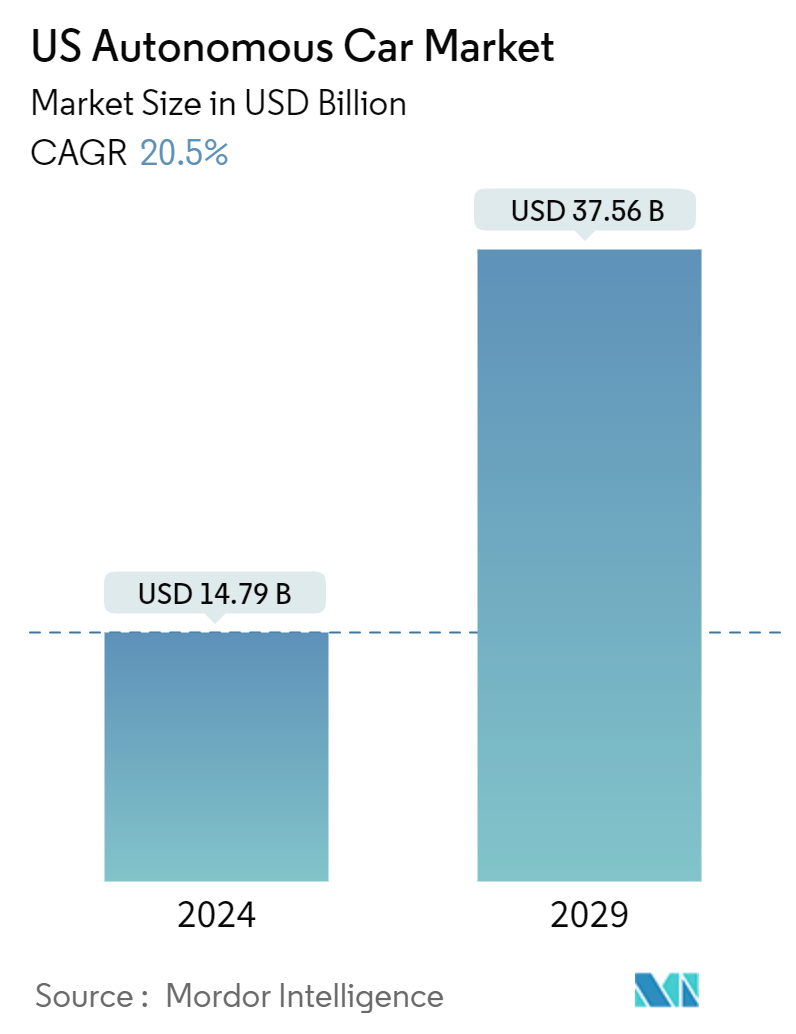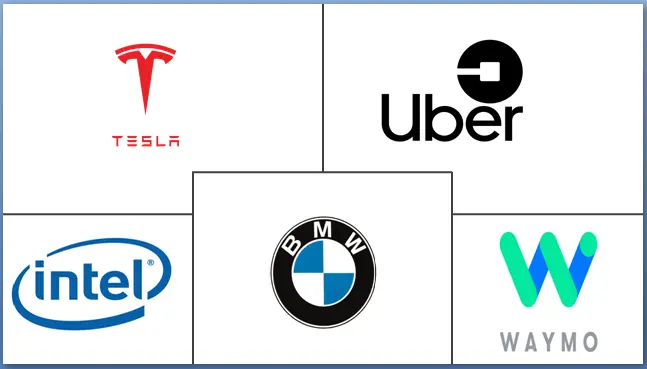Market Size of US Autonomous Car Industry

| Study Period | 2019 - 2029 |
| Base Year For Estimation | 2023 |
| Market Size (2024) | USD 14.79 Billion |
| Market Size (2029) | USD 37.56 Billion |
| CAGR (2024 - 2029) | 20.50 % |
| Market Concentration | High |
Major Players
*Disclaimer: Major Players sorted in no particular order |
US Autonomous Vehicle Market Analysis
The US Autonomous Car Market size is estimated at USD 14.79 billion in 2024, and is expected to reach USD 37.56 billion by 2029, growing at a CAGR of 20.5% during the forecast period (2024-2029).
Over the medium term, with stringent regulations by the government focused on improving road safety, more autonomous vehicles are being developed with highly advanced technologies integrated with smartphones, creating new interest among market players to attract customers. Due to rising health concerns and changing commuting patterns, the demand for personal cars among private consumers is also increasing. According to Euromonitor's Voice of the Industry survey, 13% of respondents indicated they plan to permanently increase the usage of cars for commuting short distances.
Level 4 and Level 5 (as scaled by the SAE) autonomous cars may not reach wide acceptance by 2030. However, there would be rapid growth for Level 2 and Level 3 autonomous cars, which have advanced driver assistance systems, like collision detection, lane departure warning, and adaptive cruise control.
The demand for self-driving cars in the United States has increased significantly over the past few years. The demand is well supported by collaborations between companies across the United States. For instance,
- In September 2023, Mercedes-Benz introduced the Mercedes-Benz Drive Pilot, a certified SAE Level 3 system, in the United States. This system manages dynamic driving tasks, allowing drivers to focus on other activities. The Drive Pilot system includes multiple sensors such as lidar, a rear camera, and microphones for detecting emergency vehicles.
- In May 2023, Uber and Alphabet partnered to launch autonomous vehicle services for trips and deliveries in Phoenix, Arizona.
Apart from these developments, Mexico's new trade agreement with the United States and Canada involves opportunities for the transfer of autonomous technology. However, there is room for improvement in infrastructure in the coming years.
US Autonomous Vehicle Industry Segmentation
An autonomous car can sense its environment and move with little or no human input. Autonomous vehicles are made up of numerous sensors, such as lidar and radar systems, working concurrently to carry out operations automatically or without the help of drivers. The US autonomous car market report covers the latest trends and COVID-19 impact, followed by technological developments.
The report's scope is segmented by type, sensors, and level of automation. The market is segmented by type into fully autonomous and semi-autonomous vehicles. By sensors, the market is segmented into the image, lidar, radar, ultrasonic, and other sensors.
By level of automation, the market is segmented into conditional automation (Level 3), high automation (Level 4), and full automation (Level 5)). For each segment, market sizing and forecasts are based on value (USD).
| Type | |
| Fully Autonomous Vehicles | |
| Semi-autonomous Vehicles |
| Sensors | |
| Radar | |
| Lidar | |
| Ultrasonic | |
| Other Sensors |
| Level of Automation | |
| Conditional Automation (Level 3) | |
| High Automation (Level 4) | |
| Full Automation (Level 5) |
US Autonomous Car Market Size Summary
The US autonomous vehicle market is poised for significant expansion over the coming years, driven by advancements in technology and increasing consumer demand for safer and more efficient driving options. The market is experiencing a surge in interest due to the integration of advanced technologies with smartphones and the internet, which is attracting both consumers and market players. The demand for semi-autonomous vehicles, particularly those with Level 2 and Level 3 automation, is expected to grow rapidly as these vehicles offer advanced driver assistance systems that enhance safety and convenience. The market's growth is further supported by collaborations among companies, such as Velodyne Lidar's partnership with Faraday Future, and the ongoing development of connected car technologies that facilitate vehicle-to-vehicle and vehicle-to-infrastructure communication.
Despite the challenges posed by the COVID-19 pandemic, which temporarily disrupted production and research and development activities, the market is set to benefit from government support in the form of favorable policies and rebates. The United States autonomous vehicle market is characterized by intense competitive rivalry, with major players like Tesla, Waymo, and Ford leading the charge in innovation and strategic collaborations. These companies are actively working on developing and deploying autonomous vehicles, with significant milestones achieved in testing and regulatory approvals. The market's consolidation is evident as key players engage in brand reinforcement, innovation, and mergers and acquisitions to capture a larger share of the market. As infrastructure improvements and technological advancements continue, the demand for fully autonomous vehicles is expected to witness substantial growth, positioning the United States as a leader in the autonomous vehicle industry.
US Autonomous Car Market Size - Table of Contents
-
1. MARKET DYNAMICS
-
1.1 Market Drivers
-
1.2 Market Restraints
-
1.3 Industry Attractiveness - Porter's Five Forces Analysis
-
1.3.1 Bargaining Power of Suppliers
-
1.3.2 Bargaining Power of Consumers
-
1.3.3 Threat of New Entrants
-
1.3.4 Threat of Substitute Products
-
1.3.5 Intensity of Competitive Rivalry
-
-
-
2. MARKET SEGMENTATION (Market Size in Value (USD billion))
-
2.1 Type
-
2.1.1 Fully Autonomous Vehicles
-
2.1.2 Semi-autonomous Vehicles
-
-
2.2 Sensors
-
2.2.1 Radar
-
2.2.2 Lidar
-
2.2.3 Ultrasonic
-
2.2.4 Other Sensors
-
-
2.3 Level of Automation
-
2.3.1 Conditional Automation (Level 3)
-
2.3.2 High Automation (Level 4)
-
2.3.3 Full Automation (Level 5)
-
-
US Autonomous Car Market Size FAQs
How big is the US Autonomous Car Market?
The US Autonomous Car Market size is expected to reach USD 14.79 billion in 2024 and grow at a CAGR of 20.5% to reach USD 37.56 billion by 2029.
What is the current US Autonomous Car Market size?
In 2024, the US Autonomous Car Market size is expected to reach USD 14.79 billion.

